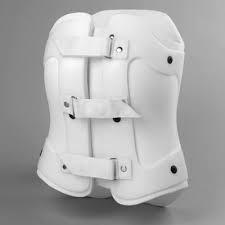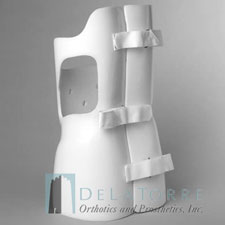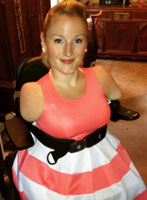|
Candidate
Individual Projects - 2016
Individual
Projects are designed to be less time-consuming for a student whose
schedule does not permit working on a team-based project but wishes to receive
a letter grade and one credit unit. Students working on an individual
project must meet with the course instructor during the second week of classes
to discuss and agree upon the specifics of the project. Also see
Required Course and Individual Project
Activities.
General Information on
Individual Projects
Focus on one of these activities that
relate to or would potentially benefit an older adult or individual with a
disability:
-
Research an assistive technology
topic - report on new products and research under
development.
-
Pursue a "paper design" of an
assistive technology device - develop a CAD design or a "low resolution"
physical device built from foam-core or other prototyping
material.
-
Create a work of art -
create an original poem, song, skit, painting, or video. (This option would be
of particular interest to students who have skills and expertise other than
engineering.)
-
Engage in an aftermarket
aesthetic design - select an existing assistive product that could benefit
from a better appearance, contact the manufacturer, and work with a user of the
device to improve its aesthetic appeal.
-
Engage in an aftermarket
functionality / usability design - select an existing assistive product
that could benefit from a better functionality or usability, contact the
manufacturer, and work with a user of the device to improve its functionality
or usability.
- Consider one of the projects
listed below.
Individual
Projects:  - new or updated project description for 2016 - new or updated project description for 2016
Back to top
 Scoliosis Brace Fasteners for Anna Scoliosis Brace Fasteners for Anna
Background: Kristin's daughter
Anna, age 13, has scoliosis and has been wearing a Boston Brace for about 3
years with about 2 more years to go. It is a simple device, which is
custom-made to fit her properly and must be remade as she grows. She is wearing
her 4th brace.
Problem: There are some issues
with the brace's design, though, that are a real nuisance:
-
The Velcro straps are very loud
when they are adjusted. Sometimes she has to adjust the brace at night and the
noise can wake family members.
-
The hook part of the Velcro straps
is very sharp and any exposed ends of the straps rip numerous holes in the back
of many of her shirts.
-
The Phillips screwdriver slots on
the screw heads (used to attach the straps to the brace) can also rip her
clothes. The brace guy sometimes puts Teflon tape over them but this fix
doesn't last very long.
Aim: Explore solutions to these
problems using an older brace that she has grown out of.
Design Criteria: Since Anna must
wear her brace 23/7, any solutions to these problems must allow her to sit in a
chair, lie down, etc.
|
Boston
Brace |
|
Front view |
|
Side view |
 |
|
 |
|
This
image shows the details of fasteners on a front-facing brace. While the
fasteners are identical to Anna's brace, hers fastens on the
back. |
|
Anna's
brace fastens in the back, as in this image. |
Back to top
 Glucose Meter Monitor Project Glucose Meter Monitor Project
Background: Thousand of veterans
across the country who have diabetes are expected to test and monitor their
blood glucose several times a day using a meter.
Problem: Many veterans with
diabetes are not able to effectively manipulate and trigger their
Accu-Chek
Aviva Glucose Meters to electronically transmit their stored blood glucose
readings from their meter to a companion Home Telehealth Monitoring Station
(via line-of-sight infrared communication) and then onto a VA nurse via an
internet connection. (See
Owner's
Booklet: Meter Memory, Setup, and Data Transfer - page 32) The simultaneous
pressing and holding of two buttons on the meter while maintaining proper
orientation with and distance to the receiver is required, a difficult
challenge for these veterans.
Aim: Explore solutions to
properly align the glucose meter and IR receiver and trigger data
transmission.
|
Accu-Chek Aviva
Glucose Meter |
 |
 |
|
Glucose
Meter |
Glucose Meter and
IR Receiver |
Back to top
 Device(s) for Holding & Manipulating Device(s) for Holding & Manipulating
-
Background:
-
Problem: People like Kim who
don't have use of their arms and hands, whether due to paralysis, amputation,
or birth defect have challenges holding and manipulating objects around
them.
-
Aim: Explore designs for a
device (or suite of devices) that would aid Kim in grasping and manipulation
tasks such as cooking, food preparation, housework, and office
work.
-
Design Criteria: The
device(s) should be light weight, assist in a variety of activities, and able
to be used independently.
-
Other:
- Links:
- Where
is the AT for Individuals without Limbs?
|
Kim |
 |
|
 |
|
Kim at home. |
|
Kim at her work desk with the mouth grabber on a
stand. |
Back to top
 Lesson Design for a Grade School Student with a Disability Lesson Design for a Grade School Student with a Disability
-
Background:
Nearpod is a mobile learning platform
that helps teachers deliver instruction using iPads (and other mobile devices)
in the classroom. It combines interactive presentation, collaboration, and
real-time assessment tools into one integrated solution.
-
Problem: Teachers strive to
provide all their students with the best possible classroom learning
experiences. Unfortunately, teachers typically design their lessons for a
general student population, overlooking the needs of students with
disabilities.
-
Aim: Develop lesson
guidelines and examples for a grade school student with a disability using
Nearpod.
- Design Process:
- connect with a Special Education
teacher
- identify a particular student
with a disability
- research best practices in
lesson design for this disability
- create new or modify existing
lessons appropriate for the grade, topic, and disability
- receive feedback from the
Special Education teacher on lesson's the effectiveness
- compose a guideline document for
developing educational lessons for this disability as a part of project
report
-
Other: The project is not
intended to address the computer access needs of students who are blind or deaf
or those with mobility impairments that challenge their ability to respond to
lessons: entering text, drawing, or making choices on the
display.
- Links:
- Graphite -
Nearpod Editorial
Review
- Nearpod
video (1:13)
- Making Tech Simple -
Nearpod
Introduction
- Edshelf -
Nearpod Review (with video
0:40)
Back to top
 User
Survey of Power Wheelchair Desirable Feature and Capabilities User
Survey of Power Wheelchair Desirable Feature and Capabilities
Survey power wheelchair users to
identify desirable features and capabilities that could be incorporated into
future wheelchair designs. Include both wheelchair and user safety items as
well as information about the surrounding infrastructure and route being
traveled.
Back to top
Projects employing
inexpensive voice-recognition technology
-
Background: Thirty years
ago, voice recognition systems were in their infancy. A typical system cost
$3000 and required considerable user training to recognize just a few words.
Today, the cost of these devices has fallen sharply while the performance has
improved greatly.
-
Aim: Explore an application
for a person with a disability using an inexpensive voice recognition product.
Examples include enhanced computer control and accessibility for those with
limited manipulation abilities, control of household appliances (lights, TV,
music system), and operation of a hospital
bed.
-
Design Criteria: The device
should be appropriate for the user's abilities and be simple to configure and
use.
-
Other:
- Links:
- EasyVR Shield
- Voice Recognition
Module
- Speech
Recognition with Arduino
Back to top
Pooper scooper for canine
companions of wheelchair users
-
Problem: Wheelchair users
who walk their dogs need to clean up after them. Limited hand / arm strength
and reduced mobility can affect the dog owner's ability to successfully perform
both the collection and bagging portions of this task.
-
Aim: Explore designs for a
pooper scooper system that will be easy for pet owners with a disability to
use.
-
Design Criteria: The
improved scooper design can employ commercially available components, but must
be simple in design, lightweight, convenient to store on the wheelchair, easy
to use by pet owners with limited hand / arm movement, and inexpensive to
fabricate.
-
Other:
- Links:
Back to top
Project employing the
Microsoft Kinect Controller
-
Background: Kinect is a 3D
motion sensing input device designed for the Xbox 360 video game console and
Windows PCs. It enables users to control and interact with computers wirelessly
and hands-free, through a natural user interface using full body gestures and
spoken commands.
-
Aim: Explore an application
for a person with a disability using the Kinect Controller product. Examples
include enhanced computer control and accessibility for those with limited
manipulation abilities, physical therapy coach, control of household appliances
(lights, TV, music system), operation of Bluetooth devices (iPhone), and
implementation of an on-screen keyboard.
-
Design Criteria: The device
should be appropriate for the user's abilities and be simple to configure and
use.
-
Other: For this project,
Microsoft will make available 1 or 2 "older" Kinect sensor bars which can be
used with the companion SDK for Windows.
- Links:
- Kinect for Xbox 360
- Gesture-Based Design
Engineering (with video 3:27)
Back
to top
Household Tasks
Project
-
Problem: Older adults often
find it difficult to perform everyday household tasks such as hanging curtains,
fixing household devices, cleaning windows, ironing, and making the
bed.
-
Aim: Explore device designs
that are capable of improving or restoring the ability of older adults to
attend to daily household tasks, especially the most basic ones such as making
the bed and ironing.
-
Design Criteria: The design
should be intuitive and safe to use, highly reliable, lightweight, and easy to
handle, clean, and store.
- Links:
Back
to top
Shower / Bathtub / Sink /
Toilet Cleaning Project
-
Problem: For older adults to
remain in their current housing (as they desire), they must be able to
independently maintain the cleanliness of their house, including its shower,
bathtub, sink, and toilet. While there are numerous cleaning products on the
market, none adequately addresses the problem. [What are some of their
limitations?]
-
Aim: Explore design
solutions for the shower / bathtub / sink / toilet cleaning problem for an
older adult with a disability.
-
Design Criteria: The
design(s) must be economical, esthetically pleasing, as well as easy and safe
to use while performing the cleaning task. The design will be driven by the
user's abilities.
- Links:
Back to top
Dog Leash Project
-
Problem: Wheelchair users
who walk their dogs need their hands to both control their pets and propel
their wheelchairs. A leash that is simply tied to the wheelchair can get caught
under the wheels and interfere with the brake mechanism. And a strong dog may
be able to tip the owner's wheelchair.
- Users of rollators (walkers) also
experience similar problems.
-
Aim: Explore designs for a
dog leash system that will be easy for users to attach to their wheelchairs or
rollators independently, prevent the leash from being caught under the
wheelchair or rollator, and avoid being tipped over by a strong
dog.
-
Design Criteria: The
improved leash design can employ commercially available components, but must be
simple in design, lightweight, easy to attach by pet owners with limited hand
movement, provide a reliable release, and be inexpensive to
fabricate.
Back to top
 Individual Projects Suggested by the Ideation Workshop Senior User
Insights Panel Individual Projects Suggested by the Ideation Workshop Senior User
Insights Panel
Address concerns expressed by the
Ideation
Workshop Senior User Insights Panel for the
Stanford Center on Longevity's
Design Challenge, "Enabling Personal
Mobility across the Life Span".
The result of the individual student
project efforts should be ideas, concepts, or low-resolution models rather than
functional prototypes.
-
lifting individuals who have fallen
in their home (either with or without the assistance of another family
member)
-
promoting community participation
through enhanced use of transportation and communication
systems
-
improving appearance and
beauty
-
sustaining mobility and activity
after a diagnosis of Parkinson's or other similar conditions
-
addressing technophobia through
instructional techniques
-
making new friends and maintaining
current relationships in the community
-
redesigning communities for older
adults
Back
to top
Individual Projects with
Veterans with Spinal Cord Injury
1. Problems and needs
expressed at SCI Peer Support Group Meeting
- Manipulating
objects:
- picking up dropped items, especially
from under tables or chairs
- reaching items high on
shelves
- carrying items such as papers and
groceries
- retrieving mail from a
mailbox
- BBQ implements
- handling a bank card at an
ATM
- handling money - both coins and
bills
- Accessing the
real-world:
- charging system for powered
wheelchair users
- mounting an iPhone camera for a
photographer with C5/6 quadriplegia
- opening doors
- opening a 2-liter bottle
- preparing food and cooking tasks,
including making sandwiches and heating soup
- controlling appliances such as the
TV, telephone, electric bed, music system, nurse call, etc.
- HouseMate ECU for Android
Configurator
- VoiceIR Environmental Voice
Controller Configurator
- transferring to / from wheelchair
to bed or shower
- tele-visiting / tele-working with
family / co-workers at home/office during hospital stay
- selecting groceries remotely for
delivery
- designing an arm ergometer that
would allow users to strap themselves in
- exploring joystick concepts that
would accommodate a variety of shaft geometries
- building a cup holder that can fit
on any wheelchair
- Recreational
activities:
- Caregiver (family, nurse, and
therapist) assistance
2. Fishing rod, wheelchair
brackets, accessible digital camera, lap tray system
- A device to operate a fishing rod
for a user without use of upper extremity - to reel the line in/out, lock the
reel, etc
- existing products
from Broadened Horizons
- A bracket design for new power
wheelchairs that would allow use of an overhead sling system
- A bracket system for power
wheelchairs that would work with a mobile arm support system
- A device that would allow a high
level quadriplegia (C4) to use a digital camera. It need not be able to adjust
position of camera, but it should include a feature to snap a photo for users
with diminished hand function.
- existing
products from Broadened Horizons
- A lap tray system that is compatible
with the new wheelchair designs
- Links:
Back to top
 Specific Individual Projects Specific Individual Projects
1. Accessibility
Survey
-
Aim: Perform an
accessibility survey and analysis of a new Stanford building. (This project
might best be accomplished by two students performing surveys of two buildings
- one doing the measuring, the other recording and swapping roles between
buildings.)
2. Customize the
Cane
-
Aim: Explore ways to add a
personal aesthetic to a user's cane.
3. User-friendly Android
App
-
Aim: Create an Android app
interface for users with limited vision for
blinddroid.
4. Age-Appropriate Learning
Material
-
Aim: Explore design concepts
for age-appropriate learning material for adult participants with K - 3 grade
reading level.
5. Age-Appropriate Sensory
Engagement
-
Aim: Explore dignified
design concepts for age-appropriate sensory stimulation items for adult
participants with diminished cognitive functioning.
Back to top
 Other Individual Projects Other Individual Projects
- Accessible interfaces for
commonly-used devices:
- iPods / iPads / mp3
players
- Cell phones
- Remote controls
-
- Toys for kids with
disabilities
-
- Projects benefitting
children with Autism
-
- Projects benefitting
parents with disabilities
-
- Projects supporting equal
access to extracurricular sports activities for students with
disabilities
-
- Assistive technology
project defined by Google[x]
-
- Assistive technology
project defined by Avenidas
-
- Software projects
suggested by Project: Possibility
-
- Revisit projects listed in
NSF guide:
- Engineering Senior Design Projects to
Aid Persons with Disabilities
-
 Student-defined Individual Projects: Student-defined Individual Projects:
- Meet with the course instructor
to discuss and agree upon the specifics of the project. Interview, observe, and
discuss assistive technology problems with an individual with a disability or
older adult. Address their desire to participate in one of the following
activities by designing an adaptation to an existing device / tool or creating
a new, more useful one.
-
-
Activities of Daily Living
- cooking, showering or bathing, dressing, cleaning, housework, yard work,
employment, education, shopping, commuting, etc
-
Sports and Exercise -
walking, running, indoor and outdoor sports, etc
-
Leisure Activities and
Hobbies - collecting, model making, crafts, board games & videogames,
etc
Back to
top
|